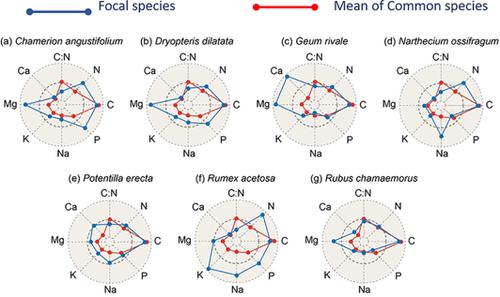当前位置:
X-MOL 学术
›
Ann. Appl. Biol.
›
论文详情
Our official English website, www.x-mol.net, welcomes your feedback! (Note: you will need to create a separate account there.)
Release from sheep‐grazing appears to put some heart back into upland vegetation: A comparison of nutritional properties of plant species in long‐term grazing experiments
Annals of Applied Biology ( IF 2.6 ) Pub Date : 2020-04-27 , DOI: 10.1111/aab.12591 Robert H. Marrs 1 , HyoHyeMi Lee 1 , Sabena Blackbird 1 , Leslie Connor 1 , Susan E. Girdwood 2 , Michael O'Connor 1 , Simon M. Smart 3 , Robert J. Rose 3 , John O'Reilly 4 , Richard C. Chiverrell 1
Annals of Applied Biology ( IF 2.6 ) Pub Date : 2020-04-27 , DOI: 10.1111/aab.12591 Robert H. Marrs 1 , HyoHyeMi Lee 1 , Sabena Blackbird 1 , Leslie Connor 1 , Susan E. Girdwood 2 , Michael O'Connor 1 , Simon M. Smart 3 , Robert J. Rose 3 , John O'Reilly 4 , Richard C. Chiverrell 1
Affiliation

|
Rewilding or wilding is a popularised means for enhancing the conservation value of marginal land. In the British uplands, it will involve a reduction, or complete removal, of livestock grazing (sheep), based on the belief that grazing has reduced plant species diversity, the ‘Wet Desert’ hypothesis. The hope is that if livestock is removed, diversity will recover. If true, we hypothesise that the species extirpated/reduced by grazing and then recover on its removal would more nutritious compared to those that persisted. We test this hypothesis at Moor House National Nature Reserve (North‐Pennines), where seven sets of paired plots were established between 1953 and 1967 to compare ungrazed/sheep‐grazed vegetation. Within these plot‐pairs, we compared leaf properties of seven focal species that occurred only, or were present in much greater abundance, in the absence of grazing to those of 10 common species that were common in both grazed and ungrazed vegetation. Each sample was analysed for macro‐nutrients, micro‐nutrients, digestibility, palatability and decomposability. We ranked the species with respect to 22 variables based on effect size derived from Generalised Linear Modelling (GLM) and compared species using a Principal Components Analysis. We also assessed changes in abundance of the focal species through time using GLMs. Our results support the ‘Wet Desert’ hypothesis, that is, that long‐term sheep grazing has selectively removed/reduced species like our focal ones and on recovery, they were more nutritious (macro‐nutrients, some micro‐nutrients) palatable, digestible and decomposable than common species. Measured changes in abundance of the focal species suggest that their recovery will take 10–20 years in blanket bog and 60 years in high‐altitude grasslands. Collectively, these results suggest that sheep grazing has brought about biotic homogenization, and its removal in (re)wilding schemes will reverse this process eventually! The ‘white woolly maggots’ have eaten at least part of the heart out of the highlands/uplands, and it will take some time for recovery.
中文翻译:

放牧放牧似乎使心脏重新回到了高地植被:长期放牧实验中植物物种营养特性的比较
荒野或荒野是提高边际土地保护价值的一种普遍手段。在英国的高地地区,这将涉及减少或完全清除牲畜放牧(绵羊),因为人们相信放牧会减少植物物种的多样性,即“湿沙漠”假说。希望是,如果牲畜被清除,多样性将会恢复。如果为真,我们假设与放牧相比,通过放牧而灭绝/减少然后恢复的物种将更有营养。我们在Moor House国家自然保护区(北奔宁州)测试了这一假设,该地区在1953年至1967年之间建立了七对成对的地块,以比较未草化/绵羊草的植被。在这些地块对中,我们比较了仅出现的七个焦点物种的叶片特性,或在没有放牧的情况下,以放牧和未草木化植被中常见的10种常见物种的数量出现。分析每个样品的大量营养素,微量营养素,消化率,适口性和可分解性。我们根据源自广义线性建模(GLM)的效应大小,针对22个变量对物种进行了排名,并使用主成分分析对物种进行了比较。我们还使用GLM评估了随时间变化的焦点物种的丰度变化。我们的结果支持“湿沙漠”假说,即长期放牧已选择性地去除/减少了像我们重点羊这样的物种,并且在恢复时,它们更有营养(宏营养素,一些微量营养素)可口,易消化而且比普通物种可分解。实地物种丰富度的测量变化表明,它们在沼泽地恢复需要10–20年,在高海拔草原需要60年。总的来说,这些结果表明,放牧绵羊已经实现了生物均质化,而在(再)野生计划中将其清除将最终逆转这一过程!“白色羊毛”已经从高地/高地吞噬了至少一部分心脏,这需要一些时间才能恢复。
更新日期:2020-04-27
中文翻译:

放牧放牧似乎使心脏重新回到了高地植被:长期放牧实验中植物物种营养特性的比较
荒野或荒野是提高边际土地保护价值的一种普遍手段。在英国的高地地区,这将涉及减少或完全清除牲畜放牧(绵羊),因为人们相信放牧会减少植物物种的多样性,即“湿沙漠”假说。希望是,如果牲畜被清除,多样性将会恢复。如果为真,我们假设与放牧相比,通过放牧而灭绝/减少然后恢复的物种将更有营养。我们在Moor House国家自然保护区(北奔宁州)测试了这一假设,该地区在1953年至1967年之间建立了七对成对的地块,以比较未草化/绵羊草的植被。在这些地块对中,我们比较了仅出现的七个焦点物种的叶片特性,或在没有放牧的情况下,以放牧和未草木化植被中常见的10种常见物种的数量出现。分析每个样品的大量营养素,微量营养素,消化率,适口性和可分解性。我们根据源自广义线性建模(GLM)的效应大小,针对22个变量对物种进行了排名,并使用主成分分析对物种进行了比较。我们还使用GLM评估了随时间变化的焦点物种的丰度变化。我们的结果支持“湿沙漠”假说,即长期放牧已选择性地去除/减少了像我们重点羊这样的物种,并且在恢复时,它们更有营养(宏营养素,一些微量营养素)可口,易消化而且比普通物种可分解。实地物种丰富度的测量变化表明,它们在沼泽地恢复需要10–20年,在高海拔草原需要60年。总的来说,这些结果表明,放牧绵羊已经实现了生物均质化,而在(再)野生计划中将其清除将最终逆转这一过程!“白色羊毛”已经从高地/高地吞噬了至少一部分心脏,这需要一些时间才能恢复。


























 京公网安备 11010802027423号
京公网安备 11010802027423号